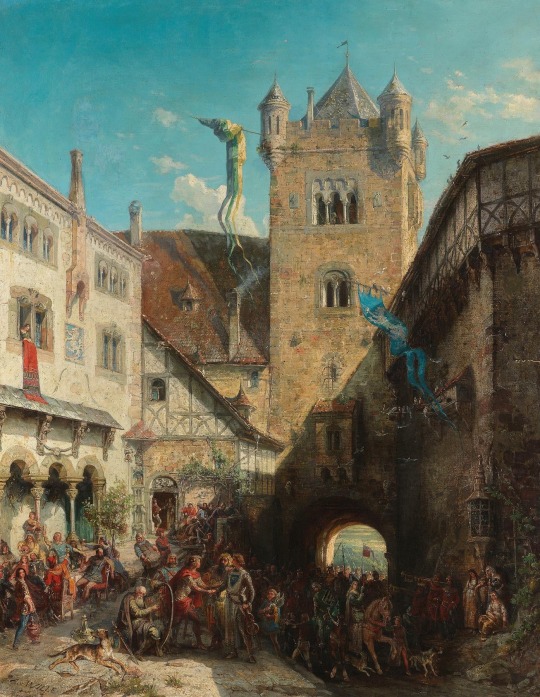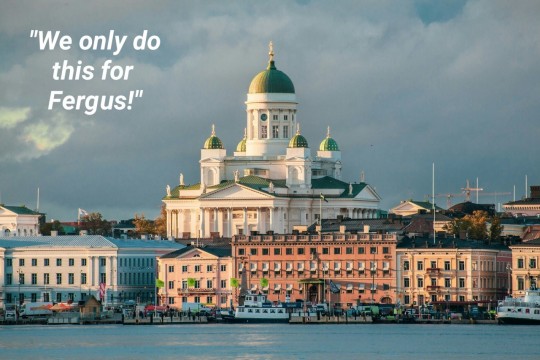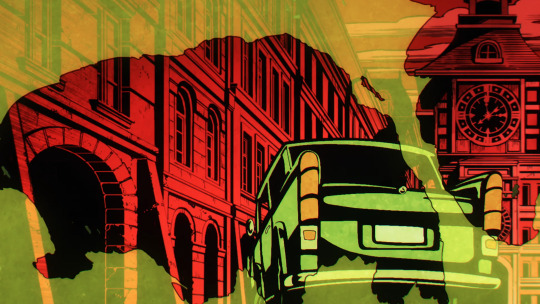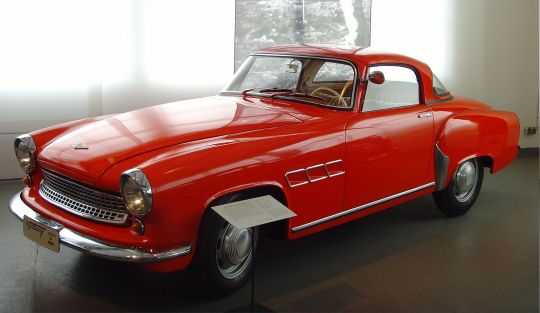#war of the wartburg
Explore tagged Tumblr posts
Text

The Singers' Quarrel at Wartburg Castle by August von Wille
#august von wille#art#wartburg castle#medieval#middle ages#germany#minnesang#minnesinger#german#thuringia#courtly love#knights#history#minnesänger#eisenach#castles#castle#war of the wartburg#chivalry#chivalric romance#european#europe#singers#poets#singer#singing#knight#romantic#song#songs
126 notes
·
View notes
Text
Eisenach
Eisenach ist eine Stadt in Thüringen, in der Nähe von der alten innerdeutschen Grenze. Etwa zweiundvierzigtausend Leute wohnen in Eisenach, und in den zwölften und dreizehnten Jahrhunderten war es die Haupstadt von Thüringen. Die Stadt legt am Fluss Hörsel und zwischen dem Thüringer Wald, dem Hainich und dem Osthessischen Bergland. Eisenach ist berühmt für die Wartburg, die UNESCO-Welterbe ist. Martin Luther hat in der Wartburg die Bibel ins Deutsche übersetzt. Andere Wahrzeichen sind die Automobile Welt, das Thüringer Museum, und das Lutherhaus, das zerstört in 1944 und wiederhergestellt in 1966 wurde. Eisenach ist auch der Geburtsort von Johann Sebastian Bach.



#langblr#learning languages#language learning#learning german#germanblr#eisenach#thüringen#germany#agtew
7 notes
·
View notes
Photo

Foto: Panorama Helsinki / Finland - Cathedral and Place of the Parliament (by tap5a)
“We only do this for Fergus!” is a short Outlander Fan Fiction story and my contribution to the Outlander Prompt Exchange (Prompt 3: Fake Relationship AU: Jamie Fraser wants to formally adopt his foster son Fergus, but his application will probably not be approved… unless he is married and/or in a committed relationship. Enter one Claire Elizabeth Beauchamp (Randall?) to this story) @outlanderpromptexchange

Chapter 23: Preparing for Christmas
In the days following Claire and Jamie's foray into the world of Christmas decorating, routine returned to the Fraser household. Jamie worked from home at times, and at times he drove to work. But throughout, he was home relatively early in the evenings to spend time with Fergus. Normally, he had always put the boy to bed alone on such occasions. But since their trip to Wartburg Castle together, it had become more and more common for Claire and Jamie to put Fergus to bed together.

Picture by Guillaume Bourdages auf Unsplash Whenever Jamie was out of the house, Claire took the opportunity to practice or prepare some little surprises with Fergus for Christmas. Fergus was enthusiastic about the task and looked forward to being able to surprise his dad on the upcoming holidays. Claire watched Fergus' enthusiasm with great delight. In general, the past few weeks had brought her so many little and bigger joys. She had to smile when she thought back to Fergu's first St. Nicholas Day. The boy was allowed to put two boots outside the front door of Fraser's apartment the night before St. Nicholas Day. Mrs. Curtius, not wanting to miss the opportunity to give the "Knirps," as she affectionately called Fergus, a present, had encouraged him to put one of his boots outside her apartment door as well. As might be expected, the boy could hardly sleep the night before St. Nicholas Day. Two hours after Jamie and Claire put Fergus to bed, Fraser had retired to his bedroom as well. Jamie enjoyed the quiet evening hours when everything in the house had gone quiet and he could read a few more pages in a book while lying peacefully in his warm bed. Fraser had just finished a new chapter in a book about the Seven Years' War that Matthieu had recommended to him when he heard some suspicious noises in the hallway. With just one big jump, he was out of bed and standing at the door of his bedroom. Sounds reached his ear from the hallway, implying that someone was rattling the door to his apartment. Jamie smiled, then silently opened the door. As expected, Fergus was standing there, trying to open the apartment door that Fraser had wisely locked the night before.

Picture by annca from Pixabay "Fergus? What are you doing?" The boy startled and seemed to freeze into his statue. He closed his eyes and fumbled at the apartment door. Then he turned and walked back toward his nursery, eyes still closed. "Aha," Fraser thought, "we're pretending to sleepwalk." He couldn't help but grin widely. "Fergus?" asked Fraser, then he grabbed the child and took him in his arms. "Fergus, what are you doing here? Did you come to see if St Nicolas had come yet?" The boy, more than aware that his Papa had seen right through him, meekly let the word "yes" escape his mouth. "You're excited, aren't you? You're wondering what St. Nicolas will surprise you with? I'm sure it's little nice things you'll be happy about." "Really, Papa?" "Yes, I'm sure it is." Jamie put the child back to bed and also read him a story from his book about the Middle Ages. Then he said goodbye and went back to his bedroom. When he looked into Fergus' room agaion 40 minutes later, the boy had fallen asleep. The next morning, Jamie woke Fergus and together they opened the apartment door. With enthusiasm, Fergus emptied the two boots. Out came nuts, tangerines, his favorite chocolate and an eraser in the shape of a knight, a new ruler with his name etched on it, and two pencils. Like a robber, Fergus gathered everything up and immediately took it to his room, where he stowed it in an extra box. Jamie followed him, then helped him shower and dress. As Fraser helped Fergus tie his shoes, the boy asked: "Do we have to have breakfast before I can check on the boot at Mrs. Curtius'?" Jamie smiled. "No, you may check first to see if St. Nicolas left anything there, too." Shortly thereafter, they found themselves at Mrs. Curtis' front door and Fergus' joy knew no bounds. In his boot he found a metal box with beautiful crayons, tangerines, an orange studded with cloves on a red velvet ribbon, some nuts, and ... of course ... a bar of his favorite chocolate. "Well?" asked Jamie, "aren't you going to thank Mrs. Curtius for reminding you to put a boot outside her door too?" "Thank you, Mrs. Curtius!" "You're welcome, Fergus!" Jamie and Mrs. Curtius smiled at each other while Fergus packed up the gifts and carried them up to his room. "Come right back down, though, Fergus! We need breakfast and you need to get to school!" "Yes, Papaaaa!"

Picture by Lucas Hoang from Unsplash Afterwards, as they ate breakfast together with Claire, Fergus could hardly contain his delight at the St. Nicolas issues. He talked without stopping, so Jamie and Claire had to keep reminding him to eat his roll or drink his cocoa. Finally, Jamie was able to drive the child to school. When he returned, Claire was standing in the living room with her big notepad, measuring the space around the fireplace. "What's this going to be when it's done?" asked Jamie, dropping down on the sofa with a loud sigh. Claire looked at him with a smile. "Well, Dad? Did our little knight talk your ear off? How many more times did you hear the word 'St. Nicolas' on the ride to school?" "Too many times!" replied Fraser, closing his eyes. Then they laughed together and Jamie sat up. Claire sat down with him and showed him a drawing on her pad. He could see that it was a plan showing where the Christmas tree and other decorations would be placed. "Oh, that looks good, yes, I can even picture it a little bit already." They talked for a while longer about preparations for the holiday, then Jamie took his leave for his study. At noon, Fraser picked Fergus up from school again. But now, to his surprise, the child was almost completely silent. When Claire had greeted Fergus and they were finally seated at the lunch table, Fergus was still silent. Silently he spooned his soup, silently he stuffed his fries, chicken and salad into his mouth." Claire worried. Where had the happy child from the morning gone? What had happened? She couldn't hold on any longer, and after the child ate the last bite, she asked: "Fergus, you're not telling anything. What happened at school?" Thick tears now welled up from the boy's eyes and ran down his cheeks. Claire was with him immediately, taking him in her arms and carrying him to her chair. She stroked his hair as Fergus continued to cry and sob. Jamie looked to her in alarm. She made a gesture and he understood that she needed a handkerchief. He quickly handed her a fresh handkerchief. She wiped Fergus' tears and let him blow his nose. While rocking him back and forth on her lap like a baby, she gently asked him again: "Fergus, what happened?"

The traditional lunch at the day of Holy Night * Picture by 3268zauber - Eigenes Werk, CC BY-SA 3.0, https://commons.wikimedia.org/w/index.php?curid=5544789 "At school ... we ... all found a chocolate with the image of St. Nicolas and a little candle in our seats. Mrs. Dynevor lit the candle on the Advent wreath on the teacher's desk and then all our little candles. Then Mr. Baltumeit came and read the St. Nicholas story to us again from an old book, and at the end we sang a Christmas carol." "But surely that was nice?" asked Claire in amazement. "Yes, it was very nice ..." "But?" "At the big break, I was with Joshi and Claus in the schoolyard and then ..." The boy sighed audibly before continuing: "... Max Hohenfels came and Peter and Bernhard were also there ... and when I told Joshi and Claus what Santa Claus had brought me .... Max, Peter and Bernhard laughed at me. They said I was stupid. Because ... St. Nicolas doesn't exist and the things we found in the boots were from our parents ..." Fergus began to cry again. Jamie and Claire looked at each other and without exchanging words they knew what to do. Fraser stood up, took Fergus from Claire's lap and carried the boy into the living room. Together they all sat down on the sofa, Fergus in their midst. "Fergus," Jamie began, "it's true that St. Nicholas, I mean, the St. Nicolas who brings gifts to children, is a mythical figure. But he has a role model in history who really lived." "I know ..." the boy answered softly. "Were you sad, then, because the story about St. Nicholas bringing presents is just a legend?" asked Claire, who had difficulty understanding exactly what was troubling the child. "No," Fergus replied, "I know it's a legend. It's not like I'm stupid. But it's still nice to pretend it's true for a day." Claire hugged the boy to her: "Yes, of course, and you're allowed to do that. As long as we know how to distinguish truth from made-up, it's not a problem." Once again Jamie and Claire looked at each other. Then suddenly they heard a voice from the dining room: "Doesn't anyone want their dessert today?" Of course, no one wanted to give up their dessert, so shortly after, all three of them were back at the table eating a delicious berry compote with cream. After dinner, Fraser took the boy to his study where he helped him with his homework. When they all met again later for tea, Fergus had regained his enthusiasm and when he and Jamie played together with his train set after tea, she could even hear "the men" laughing out loud from time to time. Unstoppably, the month of December progressed. The first Advent, was followed by the second, then the third, and finally the fourth. On Monday, December 22, the Christmas tree was brought in first, followed by the Christmas decorations. Claire had scheduled the times so that Fergus was at school. With the help of Mrs. Bodenser, she stowed the packages of Christmas decorations in a room that faced the living room and was not in further use. The two women then sat down in the dining room, where they shared a cup of coffee and discussed the list of delivered items. Then Alice Bodenser brought up the conversation of some craft classes she was planning to offer in the coming year in Berlin and Potsdam for both children and adults, and invited Claire to attend. When they said goodbye, they had not only agreed to address each other by their first names in the future. Claire had also gained the impression that a new, good friendship had been formed.

Christmas market at Palace Charlottenburg * Picture by Reiseuhu.de from Unsplash Now time was flying by. On Christmas Eve, a Wednesday, Jamie and Mr. Curtius got up early. Then, with the help of long ropes, they hoisted the Christmas tree, which had been well hidden from Fergus' eyes, down in the garden, first onto the balcony and then from there into the living room. Together, the men freed the tree from the net that held its branches together and then made sure it came to rest safely in a heavy stone block. After about one hour everything was done. Claire locked all the doors leading into the living room and lowered the shutters both in front of the windows and in front of the conservatory door, through which one could see into the living room. Then she sent Jamie to Fergus to wake the boy, shower him, and get him dressed. At 8:30 a.m. they all sat together at breakfast and discussed how they were going to spend that day. Jamie and Fergus would go into town first to, as Jamie said, to get some last minute gifts. They would be back for lunch. Afterwards, “the men” wanted to take a trip to the Potsdam Christmas market. That's just what happened. Claire was grateful that Jamie had offered to do something with the boy that day. So she was able to decorate the living room and especially the Christmas tree with the help of Marthe Alderburg, a young woman who had worked for them many times before as a very trustworthy temp. Promptly at 12:30 Fergus and Jamie were back. Shortly thereafter, Mrs. Curtius served the traditional Christmas Eve dinner for everyone: Sausages with potato salad. Then "the men" went on their way again. Claire and Marthe did the remaining chores and Mrs. Curtius started preparing the Christmas dinner in the kitchen. Surprisingly, "the men" returned home at 3:00 p.m. already. Both looked a bit exhausted. Jamie explained that they had decided to get some more rest because the evening was going to be long. Jamie and Fergus adjourned to the boy's room, where Jamie read to Fergus from his medieval book, and they both fell asleep a short time later. Shortly after 4:00 p.m., Jamie was awakened by the vibration of his smartphone. Claire informed him that he and Fergus needed to get changed now, as they had tea at 4:45 p.m. and had to leave for the Christmas Eve service at 5:30 p.m. if they wanted to get a seat in the church yet. Claire herself, with a great feeling of happiness, had finished the work in the living room and then locked it. No one was to see the room before the actual festive moment. She had then gone to her apartment and changed her clothes. The generous salary she received and the fact that she didn't have to pay rent or pay for her meals had allowed Claire not only to pay off her late husband's debts each month, but also to save a little. A few weeks earlier, on her day off, she had been in Berlin and picked out two new dresses. One, in a dark red tone, for Christmas Eve and another, in a dark green death, for the visit to Matthieu and Teresa von Klarenberg on the secon Day of Christmas. When Fergus and Jamie entered the dining room, where Claire was already standing at the table lighting the candles of the Advent wreath, they were amazed to see Claire in her new dress. She was also wearing a gold necklace, gold earrings with garnet stones, and a ring just like them - jewelry that her Uncle Lambert had given her and that perfectly matched the color of the dress.

Christmas market at the Gendarmenmarkt/Berlin * Picture by Birk Enwald from Unsplash "Well, are you amazed?" she asked, amused, when she saw the surprised expression on "the men's" faces. "You guys got dressed up too, am I supposed to celebrate Christmas in my everyday clothes?" "No, no!" they both said as if from the same mouth. Shortly after, Jamie found his voice again and said: "You look ... quite wonderful ... Claire." The thus addressed said nothing, but only smiled. Somewhat disconcerted, Fraser nudged Fergus and prompted: "Say it, Fergus! Claire looks quite ... wonderful, doesn't she?" "Yes, yes, quite, quite wonderful," the boy hastened to agree with his father. Claire looked at them in amusement, then pointed to the table where Mrs. Curtius had provided tea, sandwiches and small cakes: "Come, sit down, we don't have quite as much time today." At 5:30 p.m., they left the house to go to the Christmas Eve service. A few weeks earlier, Claire and Jamie had agreed that they wanted to attend this service at the Friedenskirche (Peace Church) in Potsdam. The Friedenskirche, located on the edge of the park of palace Sanssouci, was built from 1845 to1854 to plans by Ludwig Persius and August Stüler based on designs by King Frederick William IV. Together with the neighboring Predigerhaus (Home of the Pastor) and the small, so-called Marly Palace, the three-nave basilica is part of an architectural ensemble that combines the king's romantic religiousness with his admiration for Italy. Thus, the Friedenskirche has its model in the early Christian building of San Clemente in Rome. Although all the buildings of the Friedenskirche are part of the UNESCO World Heritage Site, they are also home to a lively church congregation of around 1,600 people. It was this blend of tradition and modernity that immediately appealed to Jamie and Claire and that they wanted to explore.

Friedenskirche Potsdam in wintertime * Picture: Sybillesonne - Eigenes Werk, CC BY-SA 3.0, https://commons.wikimedia.org/w/index.php?curid=28655825
When they arrived at the church, it was already one-third full. They quickly looked for empty seats. It wasn't long before the rest of the church was also filled with visitors and the service began. Since they had entered the church, Fergus had looked around with interest. He knew churches, even richly decorated churches. During the time he had lived on the streets of Paris, he had also stayed in churches from time to time to sleep there. But what he saw here was new to him. Again and again he asked Fraser questions in a whisper: "And is it true, Papa, that the king who built this church is buried here?" "Yes." "With his wife in a micesoleuhmmm?" "Yes, that's called a mausoleum." "Can we see the tombs sometime? I've never seen a king's tomb before!" "Not today, but I promise you we'll come back here and take a good look at everything." "Oh yes! When are we going to do that?" "Shh, Fergus. We'll talk about that later. The service is starting." The organ intoned a first carol - "Es ist ein Ros entsprungen ..." - and the visitors present joined in the old familiar carol. Jamie was silent, for he did not know the song. To his surprise, Claire and Fergus say along vigorously. When the song had faded away and they sat down again, Fergus whispered to him, "We learned that song in school. It's one of the oldest German Christmas songs." Jamie saw a sly smile slip across Claire's face. Then he patted Fergus on the shoulder and said approvingly, "Well done."

Altar of the Friedenskirche, Potsdam (view from the organ loft) * Picture by Stefan14776 - Eigenes Werk, Gemeinfrei, https://commons.wikimedia.org/w/index.php?curid=11392888 Three more times, father and son experienced a similar situation. After a few announcements, "Es kommt ein Schiff gerladen" was sung together. Then followed Bible readings and the song "Silent Night, Holy Night." Then the pastor addressed his sermon to the congregation present, and at the end of the service all sang together "Oh du fröhliche, oh du selige". Just before the carol was sung, the lights in the church hall were extinguished, leaving only the candles on the Advent wreath and the lights on the two Christmas trees to the right and left of the pulpit shining. A slight shiver ran over Claire as the carol then sounded and she was able to sing along with it at the top of her lungs. This was, in a long time, the first joyous Christmas she had experienced. Jamie was amazed every time that Fergus not only knew the words and melodies by heart, but could hold the tune. Did his son possess musical talent? Should this be encouraged? He would have to take Claire up on it later. After the song, the lights were turned on again and the pastor gave the blessing. Slowly, people moved out of the church building. Jamie glanced at Fergus, who had hooked himself between him and Claire. Both looked at him with happy faces. He looked at them and smiled back. A comforting feeling rippled through his chest. He was with the two people he loved more than anything, his sister and her family excluded. Not only did he get to be with these two loved ones, but he also got to celebrate Christmas with them, Merry Christmas. They were just walking through the large oak door of the church when James Fraser sent another prayer to heaven. He had only one wish. That the two loved ones by his side would be well and that they could spend many, many more decades together. In any case, he promised God at that moment that he would do whatever was necessary to make that happen.
#Outlander#Outlander Fan Fiction#James Fraser#Claire Beauchamp#Fergus Fraser#Chriostmas#Holy Night#Potsdam#Friedenskirche#germany#berlin#Modern AU#We only do this for Fergus
22 notes
·
View notes
Note
(passing this along because i'm a fan of chain messages, but if you're not, let me know and i won't send you any more! ^^)
🎶✨️ when u get this, answer with 5 songs u actually listen to. then, send this ask to 10 of your followers (if you feel like it! no pressure.) 🎶✨️
oh damn I only just saw this somehow. this seems fun why not :)
(might have done 10 songs instead, woops)
Burn, Baby, Burn - Sea Power
Goldfish and Paracetamol - Catatonia
Change - King Gizzard and the Lizard Wizard
Killer Queen - Queen
War Pigs - Black Sabbath
Celebrity Skin - Hole
Inbetween Days - The Cure
Frankly, Mr Shankly - The Smiths
Agrarwissenschaften im Dienste des Sozialismus - Ifa Wartburg
Common People - Pulp
4 notes
·
View notes
Text
Martin Luther · Reformation · Legende

Martin Luther · Reformation · Legende · Wartburg
Martin Luther war eine der bedeutendsten Figuren der Reformation im 16. Jahrhundert. Eine bekannte Geschichte aus seinem Leben ereignete sich während seines Aufenthalts auf der Wartburg im Jahr 1521. Nach dem Reichstag zu Worms wurde Luther für vogelfrei erklärt, was bedeutete, dass jeder ihn straffrei töten durfte. Um ihn zu schützen, ließ Kurfürst Friedrich der Weise Luther heimlich auf die Wartburg bringen. Dort lebte Luther unter dem Decknamen »Junker Jörg« und trug zur Tarnung einen Bart und lange Haare. Während seines Aufenthalts auf der Wartburg widmete sich Luther einer monumentalen Aufgabe: der Übersetzung des Neuen Testaments aus dem Griechischen ins Deutsche. In nur elf Wochen gelang es ihm, das gesamte Neue Testament zu übersetzen. Dies war eine bemerkenswerte Leistung, die den Grundstein für eine einheitliche deutsche Schriftsprache legte und es dem einfachen Volk ermöglichte, die Bibel in ihrer Muttersprache zu lesen. Legende vom Tintenfass: Eine berühmte, wenn auch wahrscheinlich legendäre Geschichte aus dieser Zeit erzählt von Luthers Kampf mit dem Teufel. Der Überlieferung nach soll der Teufel Luther während seiner Arbeit an der Bibelübersetzung erschienen sein, um ihn zu versuchen oder zu erschrecken. Luther, so heißt es, warf daraufhin sein Tintenfass nach dem Teufel, um ihn zu vertreiben. Diese Geschichte, obwohl höchstwahrscheinlich nicht wahr, veranschaulicht Luthers innere Kämpfe und seinen festen Glauben. Sie zeigt auch, wie Luther in der Volkstradition als mutiger Kämpfer gegen das Böse dargestellt wurde. Luthers Zeit auf der Wartburg war entscheidend für die Verbreitung seiner Ideen und die Entwicklung der deutschen Sprache. Seine Bibelübersetzung trug maßgeblich dazu bei, dass sich die Reformation in Deutschland ausbreiten konnte und hatte einen enormen Einfluss auf die deutsche Kultur und Sprache, der bis heute spürbar ist. Wendepunkt: Der entscheidende Wendepunkt in Martin Luthers Leben war seine sogenannte »reformatorische Entdeckung« oder »Turmerlebnis«, die zu seiner neuen Interpretation der Gerechtigkeit Gottes führte. Diese Erkenntnis hatte weitreichende Folgen für sein theologisches Denken und letztlich für die gesamte Reformation. Reformatorische Entdeckung: Luthers reformatorische Entdeckung ereignete sich, als er über den Römerbrief 1,17 nachdachte: »Denn darin wird offenbart die Gerechtigkeit, die vor Gott gilt, welche kommt aus Glauben in Glauben«. Luther beschrieb dieses Erlebnis später als eine Art »Neugeburt«, bei der er das Gefühl hatte, »durch geöffnete Türen in das Paradies eingetreten« zu sein . Entgegen der romantisierten Vorstellung, dass diese Erkenntnis in seinem Studierzimmer stattfand, ereignete sie sich tatsächlich an einem sehr unerwarteten Ort: auf der Toilette des Klosters. Luther selbst berichtete: »Diese Kunst hat mir der Heilige Geist auf der Coca eingegeben«. Diese überraschende Ortsangabe unterstreicht die Botschaft, dass Gott den Menschen so annimmt, wie er ist, ohne Vorbehalte oder Bedingungen. Konsequenzen der Entdeckung: Diese neue Einsicht führte zu einem fundamentalen Wandel in Luthers Theologie: - Gerechtigkeit durch Glauben : Luther erkannte, dass die Gerechtigkeit vor Gott nicht durch gute Werke erlangt wird, sondern allein durch den Glauben. - Ablehnung des Ablasshandels : Diese Erkenntnis führte direkt zu seiner Kritik am Ablasshandel der katholischen Kirche. - Infragestellung der päpstlichen Autorität : Luther begann, die Macht und Autorität des Papstes in Frage zu stellen. Folgen für Luthers Leben: Luthers reformatorische Entdeckung hatte weitreichende Konsequenzen für sein persönliches Leben und seine Stellung in der Kirche: - Veröffentlichung der 95 Thesen: 1517 veröffentlichte Luther seine berühmten 95 Thesen, die den Ablasshandel kritisierten. - Konflikt mit der katholischen Kirche: Dies führte zu einem eskalierenden Konflikt mit der katholischen Kirche, der in seiner Exkommunikation am 3. Januar 1521 gipfelte. - Reichstag zu Worms: Am 17. und 18. April 1521 verteidigte Luther seine Lehre vor dem Reichstag zu Worms, was zu einem symbolträchtigen Moment der Reformation wurde. - Schutzhaft auf der Wartburg: Nach dem Reichstag zu Worms wurde Luther auf die Wartburg gebracht, wo er das Neue Testament ins Deutsche übersetzte . Luthers reformatorische Entdeckung war somit der Ausgangspunkt für eine Reihe von Ereignissen, die nicht nur sein eigenes Leben, sondern auch die Geschichte der christlichen Kirche und Europas nachhaltig veränderten. Martin Luther · Reformation · Legende · Wartburg · Person Read the full article
0 notes
Text
The right attitude (2)
Word for Today written by Bob and Debby Gass
Thursday 9th May 2024
'All things are possible to him who believes.' Mark 9:23 NKJV
Demosthenes, who was reputed to be the greatest orator in ancient Greece, had a serious speech impediment. Legend has it that he overcame it by reciting verses with pebbles in his mouth and speaking above the roar of the waves at the seashore. As a prisoner in the Wartburg castle, Martin Luther made use of his time by translating the New Testament into German. Beethoven wrote his greatest symphonic masterpieces after losing his hearing. John Bunyan wrote The Pilgrim's Progress when he was in prison. Daniel Defoe also wrote in prison, creating Robinson Crusoe. Abraham Lincoln is thought by many to be the best of the United States presidents, but he probably would not have become known as a great leader if he had not led the country through the Civil War.
Often, difficult situations seem to shape great leaders and thinkers, if their attitude is right. When a problem comes in contact with someone with the right attitude, the result is often wonderful. Every challenge is an opportunity, and every opportunity has a challenge. But it's the attitude when you approach the problem that largely determines the outcome.
When a man whose son couldn't hear or speak asked Jesus to heal him, Jesus replied, 'If you can believe, all things are possible to him who believes' (Mark 9:23 NKJV). The man replied, 'Lord, I believe; help my unbelief' (Mark 9:24 NKJV)! And Jesus healed both his son and his unbelief! If you need help with your attitude, talk to the Lord today.
0 notes
Text

Wann wird etwas zu einer Legende? Eine moderne Antwort auf diese Frage wäre: In dem Moment wo es nicht im Netz auftaucht. Nach dem Motto: „Was nicht gegoogelt werden kann, hat es nie gegeben“. Wer die Wörter „Teehaus Wiesbaden“ eingibt, landet in mehreren Teegeschäften aber nicht an einem Ort, der vor mehr als 50 Jahren für manche das Tor zur fernöstlichen Welt begann.
Ich will den werten Leser heute wieder zu einer Zeitreise einladen und zu einem Ort führen, den eigentlich jeder kannte, der in den frühen 70ziger Jahren durch das „Bermudadreieck“, also vom Bumerang bis zum Jazzhaus schlenderte, in der Szene verkehrte, hin und wieder mal ein wenig Gras schnupperte oder sich in der Wartburg, den heißen Krautrock von XHOL, Guru-Guru und Sixty-Nine reinzog. Das TEEHAUS.
Es lag nur wenige Meter von Jazzhaus entfernt in der unteren Geisbergstraße und war für kurze Zeit der Wiesbadener Szene-Treff schlechthin. Vor allem junge Musiker gaben sich hier die Klinke in die Hand. Auch die Bandmitglieder von XHOL traf man hier öfters an. Alkohol gabs keinen, dafür original indischen Tee aus Schalen und dazu Halfa, ein klebriges Zuckerzeug aus Honig, Öl und anderen Ingredienzien, das ungemein satt machte. Hin und wieder wurde auch ein Glimmstängel herumgereicht. Das führte hin und wieder zu Problemen und einmal sogar zu einem größeren Polizeieinsatz…
KEINE SPUREN IM NETZ
Wäre das jetzt ein Wikipedia-Artikel würde wahrscheinlich ein Warnhinweis drüberstehen, dass keines meiner Sätze durch eine „gesicherte Quelle“ gedeckt ist. Der werte Leser muss sich also ganz auf meine grauen Zellen verlassen, die hoffentlich nicht genau so altersgemäß ausgedünnt sind wie meine inzwischen schütteren grauen Haare. Wann das Teehaus eröffnet wurde, kann ich nur abschätzen. Vielleicht im Winter 1970 oder im Frühjahr 1971. Man kann es kaum glauben, aber ich war in dieser Zeit als „Lehrling“ in einer Wiesbadener Druckerei beschäftigt, die mich tatsächlich dazu zwingen wollte, kurze Haare zu tragen, obwohl der drei Jahre ältere Gehilfe die Haare Hintern lang trug. Ich wechselte begleitet von massiven Protesten meines „Durchhalte-Vaters“ gegen Ende1970 die Lehrstelle, so dass ich im Frühsommer 1972 mit schulterlanger Mähne und bis zum Kinn reichenden Backenbart erfolgreich meine Gehilfenprüfung ablegen konnte. Mein Arbeitsplatzwechsel Ende 1970 dürfte sich mit der Eröffnung des Teehauses in etwa überschneiden.
Das Teehaus fällt somit genau in die Zeit der Post68ziger Aufbruchstimmung, die nicht nur politisch gesehen eine Zeit der Umwälzung war. Im Gegensatz zu den Apo-Kadern und Partei-Apparat-Schicks, die eine gesellschaftspolitische Veränderung anstrebten, war die Hippie-Scene mehr auf der Suche nach „Bewusstseinsveränderungen“ und auf der „Sinnsuche“. Die Liedermache“ Witthüser und Westrupp haben diese aufregende Zeit mit folgenden Worten festgehalten: „Lasst uns auf die Reise gehen, anderes Land zu suchen.“
Genau, dies haben die Betreiber des Teehauses gemacht. Der Sehnsuchtsort der 70ziger hieß INDIEN. Dort wo bereits 1968 die Beatles – allen voran George Harrison - ihre Weihen empfangen hatten. Als die deutschen Indienfahrer aus dem Rhein-Main-Gebiet wieder heimatlichen Boden unter den Füßen hatten war nicht nur Tee im Handgepäck …, sondern auch die Idee ein Teehaus zu eröffnen. Eine Idee, die sich meines Wissens in Deutschland kaum durchgesetzt hat. Außer in Wiesbaden gab es nur noch in Gießen und Heidelberg ein ähnliches Lokal. Im Gießener Teehaus konnte man sogar seinen Schlafsack ausrollen. Gleiches war – so erinnere ich mich wage – auch in Wiesbaden möglich.
WO GÄSTE BONGOS SPIELTEN UND SPONTAN ZUR GITARRE GRIFFEN
An der Tür wurde man von Herby begrüßt, der mit seiner langen schwarzen dichten Locken-Haarpracht und kurzem Vollbart, gekleidet mit einem Art weiten Kaftan selbst wie ein Orientale oder Inder aussah aber breites Rheinhessisch sprach. Mutmaßlich von früher Kindheit an. An die anderen Mitbewohner und Betreiber des Teehauses habe ich nur schemenhafte Erinnerungen. Eine Frau, die dort wohnte, war wohl mit dem früh verstorbenen Keyboarder der XHOL liiert gewesen. Auch erinnere ich mich vage an ein kleines Kind, dass hin und wieder zwischen den Gästen herumlief. Er oder Sie muss wohl heute Mitte 50 sein. Ich frage mich als alter „APO-Opa“ manchmal: Was müssen diese Kinder in WGs, Kommunen, Kinderläden usw. in dieser wilden Zeit so alles erlebt haben? Wie haben sie diese Eindrücke verarbeitet?
Es gab in dem neuen Szene-Treff keine hochbeinigen Tische und Stühle. Mann und Frau saßen auf dem Boden. Auf Sitzkissen, wie man sie auch heute noch in sogenannten 3. Weltläden angeboten bekommt. Vorher hat jeder wahrscheinlich die Schuhe ausgezogen. Der Tee wurde meiner Erinnerung nach auf einfachen niedrigen Holzkisten serviert. Einige Szeneleute mit entsprechenden transzendentalen Weihen saßen natürlich im Yoga-Schneidersitz auf dem Teppichboden. Dazu im Hintergrund dezent die Sitar-Musik von Ravi Shankar.
Kein Alkohol, ein cooler wortkarger in sich gekehrter Wirt. Kommt da nicht Langeweile auf? Der Zeitreisende wird überrascht sein: Es waren die Gäste, die Stimmung in den Teehaus-Aschram brachten. Überall standen in allen Größen Bongos und Trommeln herum. Auch eine Gitarre lehnte an der Wand oder wurde mitgebracht. Einige der Gäste gingen auf das Konservatorium oder bereiteten sich darauf vor. In Null Komma nix war die schönste Session in Gang. Auch der Wirt trommelte mit. Manche trommelten sich regelrecht in Trance, andere griffen munter in die Seiten. Ich erinnere mich lebhaft daran, wie eine junge Frau Georges Harrison gerade erschienenes Lied „My sweet Lord“ zum Besten gab. Auch ein später in der Wiesbadener Musikszene erfolgreicher Gitarrist fand hier im Teehaus seine ersten Zuhörer. Ein anderer regelmäßiger Teehausgast betreibt heute eine Musikschule in den neuen Bundesländern. Auch bei ihm wird fleißig getrommelt.
Dass nicht nur die Musik „anturnte“ war ein offenes Geheimnis. Offen waren auch die Einblicke in das unorthodoxe Lokal. Mann saß wie auf einem Präsentierteller. Die Geisbergstraße führt in eine noble Wohngegend und so mancher, der von der Straße aus einen Blick in die Runde der bärtigen, langhaarigen Gestalten warf, konnte sich so seinen Reim machen. Obwohl mir die Zeit des Teehauses stets lang vorkam, kann sie nicht lang gewesen sein. Das Teehaus in der unteren Geisbergstraße hat möglicherweise nur ein dreiviertel Jahr existiert. Dann musste es schließen. Die Gründe für die erste Schließung sind mir nicht bekannt. Es machte 100 Meter entfernt, in der oberen Geisbergstraße, in einer alten Villa wieder auf. Diskret verborgen, möglicherweise als „Club“ – man musste klingeln - idyllisch umgeben von einem Garten. Geradezu paradiesisch. Doch wie jeder weiß, endet ein Aufenthalt im Paradies regelmäßig mit Vertreibung. Auch dieses Teehaus II war nicht von langer Dauer. Im Dichterviertel. Entweder Kleiststraße oder Hebbelstraße war die Odyssee dann beendet. Endgültig. Teehaus III, dass in dieser Zeit vor allen von Schülern besucht wurde – Gutenberggymnasium lag um die Ecke – hat wahrscheinlich Anfang 1973 endgültig seine Türen geschlossen…
Epilog.
Hiermit ist meine Zeitreise mal wieder beendet. Die Errichtung des Teehaus in der Landeshauptstadt war eine Pioniertat und Pioniere müssen sich nicht mit späteren erfolgreichen Projekten, Trends und Geschäftsmodellen messen. Als die Bhagwan in der Schwalbacher Straße im Wartburg-Gebäude ihren großen Aschram eröffneten und woke Jurastudenten der Transzendentalen Meditation huldigten, die ersten Teeläden eröffneten und zu deutschlandweiten Ketten mit Millionenumsatz wuchsen, war das Wiesbadener Teehaus längst vergessen, nicht einmal Geschichte. Es wurde Zeit, dass sie endlich mal einer erzählt, diese Geschichte, auch wenn sie heute, wie eine Legende oder ein Märchen klingt. Ich schwöre bei meinem grauen Rauschebart: Sie ist hundert Prozent wahr.
#meinungsfreiheit#teehaus#70ziger Jahre#zeitreise#Klampfen#Kiffer#Bongos Wiesbadener Szene#Indien#Wiesbaden
0 notes
Text
Das Reisen in eine neue Stadt kann eine aufregende und bereichernde Erfahrung sein. Es ermöglicht uns, neue Kulturen zu entdecken, architektonische Meisterwerke zu bewundern und die kulinarischen Genüsse der Region kennenzulernen. In diesem Artikel werden wir uns auf die historischen Schätze und architektonischen Wunder, die kulinarischen Genüsse und die lokalen Geheimnisse sowie die Geheimtipps und das Insiderwissen konzentrieren, die eine perfekte Reise in die Stadt ermöglichen. Durch die gezielte Erforschung dieser Aspekte werden wir einen umfassenden Einblick in die Schönheit und Faszination dieser Stadt gewinnen. Historische Schätze und architektonische Wunder Deutschland ist reich an historischen Schätzen und architektonischen Wundern, die Besucher aus der ganzen Welt anziehen. Egal ob es sich um alte Burgen, prächtige Schlösser oder beeindruckende Kathedralen handelt, das Land bietet eine Fülle von historischen Sehenswürdigkeiten. Ein historischer Schatz, der unbedingt besucht werden sollte, ist die Burg Eltz in Rheinland-Pfalz. Diese fantastische mittelalterliche Burg ist seit mehr als 850 Jahren im Besitz derselben Familie und ist ein wahres Juwel der Architektur. Ein weiteres architektonisches Wunder ist die Frauenkirche in Dresden. Zerstört im Zweiten Weltkrieg, wurde die Kirche in den 1990er Jahren wieder aufgebaut und ist heute ein Symbol für Versöhnung und Wiederaufbau. Die berühmte Wartburg in Thüringen ist auch ein beeindruckendes Beispiel mittelalterlicher Architektur. Diese UNESCO-Weltkulturerbestätte war ein Treffpunkt für Dichter und Gelehrte und ist eng mit der deutschen Geschichte verbunden. Neben diesen historischen Schätzen gibt es in Deutschland auch eine Vielzahl von architektonischen Wundern der Moderne. Das Bauhaus Dessau ist ein herausragendes Beispiel für modernistisches Design und wurde von Walter Gropius, einem der führenden Köpfe des Bauhauses, entworfen. In Berlin können Besucher den futuristischen Fernsehturm besichtigen, der als Symbol des Kalten Krieges gilt und eine atemberaubende Aussicht über die Stadt bietet. Die Kölner Dom ist ein weiteres architektonisches Wunder, das mit seiner gotischen Bauweise und den imposanten Türmen Besucher aus aller Welt anlockt. Kulinarische Genüsse und lokale Geheimnisse Bei einer Reise in die Region sollten Besucher unbedingt die köstlichen kulinarischen Genüsse probieren, die sie in den örtlichen Restaurants und Cafés erwarten. Die Spezialitäten reichen von herzhaften Gerichten bis hin zu süßen Leckereien, die die einzigartigen Aromen der Region widerspiegeln. Eine lokale Delikatesse, die man unbedingt kosten sollte, ist das berühmte Gericht "Aal in Gelee", das seit Jahrhunderten nach einem alten Familienrezept zubereitet wird. Ein weiteres lokales Geheimnis, das nur Insidern bekannt ist, ist die traditionelle Weinherstellung, die in der Umgebung ihren Ursprung hat. Die Weinberge erstrecken sich über malerische Hügel und produzieren eine Vielzahl von exquisiten Weinsorten, die sich ideal dazu eignen, die vielfältigen kulinarischen Köstlichkeiten der Region zu begleiten. Für diejenigen, die es lieben, kulinarische Entdeckungen zu machen, gibt es in verschiedenen Orten der Region auch traditionelle Märkte, auf denen lokale Bauern und Handwerker ihre Produkte anbieten. Hier kann man frisches Obst und Gemüse, handgemachte Käsesorten und hausgemachte Konfitüren erwerben, die die authentischen Aromen der Region perfekt repräsentieren. Darüber hinaus ist die Region bekannt für ihre einzigartige Konditorkunst, die in den örtlichen Konditoreien zu bewundern ist. Hier kann man handgefertigte Schokoladenpralinen, Kuchen und Gebäck kosten, die mit lokalen Zutaten und traditionellen Rezepten hergestellt werden. Die süßen Versuchungen sind ein absolutes Muss für alle Feinschmecker, die die kulinarischen Geheimnisse der Region entdecken möchten. In der Tabelle unten finden Sie eine Auswahl lokaler Spezialitäten, die Sie unbedingt probieren sollten: Spezialität
Beschreibung Empfehlung Aal in Gelee Herzhaftes Gericht aus der Region Unbedingt kosten Lokale Weine Exquisite Weinsorten aus der Region Weinprobe machen Frisches Obst und Gemüse Direkt vom Bauernmarkt Für ein authentisches Geschmackserlebnis Handgefertigte Schokoladenpralinen Süße Versuchungen aus der Konditorei Unbedingt probieren Geheimtipps und Insiderwissen für die perfekte Reise Bei der Planung einer Reise ist es oft wichtig, Insiderwissen zu haben, um die besten Orte und Aktivitäten zu entdecken. Deshalb haben wir einige Geheimtipps für Sie zusammengestellt, um Ihre Reise zu einem unvergesslichen Erlebnis zu machen. Vermeiden Sie überfüllte Touristenattraktionen: Anstatt sich in die Schlange vor den bekannten Sehenswürdigkeiten zu stellen, suchen Sie nach versteckten Juwelen und Geheimtipps. Fragen Sie die Einheimischen nach ihren Lieblingsorten, um einen authentischen Einblick in die Kultur und Geschichte des Reiseziels zu bekommen. Nutzen Sie lokale Veranstaltungen und Festivals: Einer der besten Wege, um in die Kultur eines Reiseziels einzutauchen, ist die Teilnahme an lokalen Festivals und Veranstaltungen. Informieren Sie sich im Voraus über bevorstehende Ereignisse und planen Sie Ihre Reise entsprechend. Probieren Sie die lokale Küche: Ein Geheimtipp für eine perfekte Reise ist es, die lokale Küche zu erkunden. Vermeiden Sie die touristischen Restaurants und suchen Sie stattdessen nach authentischen Lokalen, die von Einheimischen frequentiert werden. Probieren Sie traditionelle Gerichte und Getränke, um die kulinarische Vielfalt des Reiseziels zu entdecken. Machen Sie sich mit den öffentlichen Verkehrsmitteln vertraut: Ein weiterer Geheimtipp ist es, sich mit den öffentlichen Verkehrsmitteln des Reiseziels vertraut zu machen. Dies ermöglicht es Ihnen, sich unabhängig und flexibel zu bewegen und versteckte Orte abseits der Touristenpfade zu entdecken. Respektieren Sie die lokale Kultur: Wenn Sie reisen, ist es wichtig, die lokale Kultur und Gepflogenheiten zu respektieren. Informieren Sie sich im Voraus über die kulturellen Bräuche und Verhaltensregeln des Reiseziels, um Missverständnisse zu vermeiden und eine positive Reiseerfahrung zu gewährleisten. Nutzen Sie Reise-Apps und Online-Ressourcen: Last but not least, nutzen Sie Reise-Apps und Online-Ressourcen, um Ihre Reise zu optimieren. Von Routenplanern über Restaurantempfehlungen bis hin zu Geheimtipps von Reiseexperten gibt es viele nützliche Tools, die Ihnen helfen können, Ihre Reise perfekt zu gestalten. Ein unvergesslicher Aufenthalt in Rom Insgesamt lässt sich festhalten, dass eine Reise nach Rom ein unvergessliches Erlebnis voller historischer Schätze, architektonischer Wunder, kulinarischer Genüsse und lokaler Geheimnisse ist. Die Ewige Stadt bietet eine Vielzahl von Möglichkeiten zur Entdeckung und Erkundung, und mit den Geheimtipps und Insiderwissen, die wir in diesem Reiseführer präsentiert haben, können Reisende sicher sein, dass sie eine perfekte Reise erleben werden. Von den beeindruckenden Ruinen des antiken Rom bis zu den versteckten Juwelen in den Gassen der Stadt, Rom bietet eine Fülle von Erfahrungen, die jeden Besucher begeistern werden. Wir hoffen sehr, dass dieser Reiseführer Ihnen geholfen hat, die Ewige Stadt auf eine neue und tiefgreifende Weise zu entdecken und dass Sie bei Ihrer kommenden Reise nach Rom all die Schönheit und Faszination, die diese Stadt zu bieten hat, in vollen Zügen genießen können. Gute Reise!
0 notes
Text
Das Licht der Vernunft, christliche Aufklärung.
Einen schönen Sonntag!
“Die Vernunft ist eine von Gott geheiligte.” “Der Friede Gottes, der höher ist als alle Vernunft, bewahre Eure Herzen und Sinne.” Der letzte Sonntag im Januar ist der Bibelsonntag. In meiner letzten Pfarrstelle in Altenburg/Thüringen haben wir die Bibel a la Peter Hertzsch+ in die Brüderkirche am Markt hineingetragen. Ein besonderes Stück: es war die Bibel, die Spalatin Luther auf die Wartburg…
View On WordPress
0 notes
Text
Other places in this category:
Any war memorial and historical battlefield
Ground Zero Memorial
The Globe Theatre
Paul Revere Statue
Any religious pilgrimage site
Loch Ness
Plymouth Rock
Llech Ronw
Mount Rushmore
Wittenberg Church
Any windmill in Castilla-La Mancha
Wartburg Castle
Checkpoint Charlie and the Berlin Wall
Any site connected to Arthurian legend
Any pseudoarcheological site like the Gosford Glyphs
In high school history class we talked a lot about monuments, myths and nation-building and now unfortunately I'm obsessed with visiting "mythical" places (not necessarily mythical like fake, mythical like connected to myths and legends) including the really silly ones.
26 notes
·
View notes
Photo

David Anointed King of Judah
1 After this, David asked the Lord, “Should I go up into one of the cities of Judah?”
The Lord said to him, “Go up.”
David said, “Where shall I go up?”
The Lord said, “To Hebron.”
2 So David went there with his two wives, Ahinoam of Jezre’el and Abigail of Carmel, who was Nabal’s widow. 3 David also brought along the men who were with him, each man together with his household, and they settled in the towns around Hebron.
4 The men of Judah came there and anointed David to be king over the house of Judah.
David was told, “The men of Jabesh Gilead are the ones who buried Saul.” 5 So David sent messengers to the men of Jabesh Gilead and said to them, “You are blessed by the Lord because you performed this act of mercy and faithfulness for your master Saul by burying him. 6 Now may the Lord deal with you with mercy and faithfulness. I also will treat you well because you have done this. 7 Now let your hands be strong and courageous, for your master Saul is dead, and the house of Judah has anointed me to be king over them.”
8 However, Abner son of Ner, the commander of Saul’s army, had taken Ishbosheth, the son of Saul, to Mahanaim 9 and made him king over Gilead, Ashuri, and Jezre’el, and over Ephraim, Benjamin, and all Israel. 10 Ishbosheth, Saul’s son, was forty years old when he became king over Israel, and he reigned for two years.
But the house of Judah followed David. 11 David was king in Hebron over the house of Judah for seven years and six months.
12 Abner son of Ner and the followers of Ishbosheth son of Saul went out from Mahanaim to Gibeon. 13 Joab son of Zeruiah and the followers of David went out and confronted them at the pool of Gibeon. They took up positions on the opposite sides of the pool.
14 Abner said to Joab, “The young men should get up and compete in front of us.”
Joab said, “Yes, let them do so.”
15 So twelve representatives for Benjamin and Ishbosheth son of Saul got up and crossed over to confront twelve representatives for David. 16 Each one grabbed his opponent’s head and thrust his sword into his side. Together, they all fell. So that place, which is near Gibeon, was called Helkath Hatsurim. 17 A fierce battle took place that day. Abner and the men of Israel were beaten by the followers of David.
18 Three sons of Zeruiah were there, namely, Joab, Abishai, and Asahel. Asahel was a fast runner, like one of the gazelles out in the fields. 19 Asahel pursued Abner and did not turn aside to the right or to the left from his pursuit.
20 Abner looked behind him and said, “Is that you, Asahel?”
He said, “Yes, it is.”
21 Abner said to him, “Turn to your right hand or to your left and capture one of the young men for yourself and strip off his equipment for yourself.” But Asahel would not turn aside.
22 So Abner warned him again, “Turn aside. Stop following me. Why should I strike you to the ground? How could I face Joab your brother?” 23 But Asahel refused to turn aside, so Abner struck him in the stomach with the pointed butt of his spear. The spear came out his back, and he fell down and died right there. Everyone stopped and just stood there when they came to the place where Asahel had fallen and died.
24 But Joab and Abishai keep pursuing Abner. The sun was going down when they came to the hill of Ammah in front of Giah, on the way to the wilderness of Gibeon. 25 The Benjaminites rallied together behind Abner, joined in one formation, and took their stand on the top of one hill.
26 Abner called to Joab, “Will the sword continue to devour? Do you not know that it will be bitter when all this is over? How long will you delay telling the people to stop pursuing their brothers?”
27 Joab said, “As God lives, if you had not spoken, surely it would have been morning before the people would have given up pursuing their brothers.” 28 So Joab blew the ram’s horn, and all the people stopped pursuing Israel. They did not continue to fight.
29 Abner and his men traveled through the Arabah all that night. They crossed the Jordan, marched through the entire region of Bithron, and came to Mahanaim.
30 Joab returned from pursuing Abner and gathered together all his troops. Besides Asahel, nineteen of David’s men were missing. 31 The followers of David had struck dead three hundred sixty of Abner’s men from the tribe of Benjamin. 32 The men of Judah picked up Asahel and buried him in the tomb of his father at Bethlehem.
Joab and his men marched all night and arrived at Hebron as it was becoming light. — 2 Samuel 2 | Evangelical Heritage Version (EHV) The Holy Bible, Evangelical Heritage Version®, EHV®, © 2019 Wartburg Project, Inc. All rights reserved. Cross References: Genesis 32:2; Genesis 47:29; Joshua 10:12; Joshua 14:13; Joshua 22:9; Judges 21:8; 1 Samuel 16:13; 1 Samuel 19:17; 1 Samuel 25:42-43; 1 Samuel 27:3; 2 Samuel 5:5; 2 Samuel 8:16; 2 Samuel 3:1; 2 Samuel 3:30; 2 Samuel 4:7; 2 Samuel 18:16; 2 Samuel 22:34; 2 Kings 14:8; Nehemiah 2:18; 2 Timothy 1:16
#David anointed King of Judah#Ish-bosheth made King of Israel#War between the Houses of David and Saul#2 Samuel 2#Book of Second Samuel#Old Testament#EHV#Evangelical Heritage Version Bible#Wartburg Project Inc.
3 notes
·
View notes
Text
Cars and Trains in Spy x Family - Episode 2
Following on from episode one, episode two introduces a lot of crucial new elements, such as the opening, more cars, more trains, and of course, Yor. But as she is neither a car nor a train, I’ll ignore her here; it’s perfectly obvious that she’s awesome even without me talking about her.
The opening starts explosive like a 1960s cartoon. Explosions! Car chase! Colors! Let’s take a look at the cars in particular:

The first car in green shows the tail fin lights of the Trabant 601, the default east German (and often east german in general, since it was also exported) car.

Picture from Wikipedia commons, taken by Raphaël Thiémard, published under CC-BY-SA 2.0
The Trabi, as it’s commonly known, is one of the key signifiers of the GDR (communist east Germany); the only things that come close may be the country’s flag and the Ampelmännchen. When it was introduced in 1964, following on from two previous models, it was a fairly reasonable no-nonsense small car. It’s small two-stroke engine was already a bit of an older choice, but still also commonly found on contemporary cars in the west, for example by the company that is now Audi. It became the standard car of east Germany, to the point that half (47%) of all cars there were Trabants. However, there was essentially no development until 1990, and the curious design with cotton-based body panels was slow and expensive. If you ordered a new Trabant, you would have to wait for 12 years until you received it, which was actually the quickest you could get a new car there. In the final years there were efforts to put a modern VW engine in it, but that car only came out in 1990, when modern western cars were available, and it did not sell at all.
The other important car of the GDR is the other car seen in the intro:

Those are the taillights of the Wartburg 353, a more upmarket sedan with four whole doors and a slightly bigger (but still two-stroke) engine.

Picture from Wikimedia Commons, taken by János Tamás, published under CC-BY 2.0 license
The Wartburg suffered from all the same issues as the Trabant, like lack of updates and even longer wait times, but became less of a symbol because there were fewer of it.
Of course, this blog is named Trains In Anime, not cars in anime, and while I reserve the right to completely ignore that most of the time, if there is a train in an anime, I do want to talk about it:


That’s the station where Yor is waiting for her husband to arrive from work. And it’s not just any station; it’s Berlin Friedrichstraße.

Picture by me, feel free to use under CC-BY-SA 3.0
Yeah I didn’t get a good angle when I was there last Friday, sorry, but I think the point still stands. Note in particular the crease in the top of the station hall. Also note the street lights that seem to match reality pretty well.
Friedrichstraße is in many ways the central point of Berlin’s public transit network, sitting at the intersection of the central east-west suburban rail line (the Stadtbahn) and the central north-south rail line (the North South Tunnel), with a subway line also serving it. During the cold war, it also had the role as a border station; it was split between east and west then, which must have been very cramped.
Note that this is not Berlin Hauptbahnhof/central station, that is about half a kilometre west of here, and altogether less well connected to either public transit or anything at all.
(Random aside: If you’re in Berlin, take a trip along the Stadtbahn, with any S-Bahn line from Westkreuz to Ostkreuz or reverse, or any long-distance train through Berlin Hbf top-side; sit on the south side. You’ll get glimpses of at least 50% of important Berlin sights, like Siegessäule, Brandenburger Tor in the distance, Schwangere Auster, the chancellor’s office and parliament, the museum island, Alexanderplatz and more.)
The train on top is hauled by a DR class 119 locomotive.

Picture by me, sorry it’s bad, it was 2005 and I didn’t really know what I was doing back then.
Built from 1975 to 1985, they are not quite in the time range for the show; it would make sense to assume that they meant to use a class 118, which was built from 1960-1970 instead. The main difference from the outside is the circular side windows on the 119, which gained them the nickname U-Boot (submarine). That, and the fact that they would often “dive under” and not appear visible for weeks, because they were in the workshops due to poor reliability, especially compared to the 118. The 119s were essentially a version of the 119 that was built in Romania instead of the GDR, because Comecon rules meant that the GDR wasn’t allowed to build its own diesel locomotives anymore. Comecon rules are responsible for a lot of weirdness in east german railroading.
Personally, I don’t care that the locomotive is ten years too new; that it’s there at all is absolutely correct.
At the time that Yor is waiting, Loid is dealing with some smugglers, and he’s transporting the secured contraband in a van.

This is probably the least obscure thing we have in this show. The Volkswagen T1 van, also known as VW Bus, Microbus, Kombi, Bully and many others, is one of the defining products of this west-german company, and became the iconic Hippie van, until President Johnson raised import duties in order to protect North American chicken farmers.

Picture from Wikimedia Commons, posted by Helena, published under CC-BY-SA 2.0
This starts a trend in the show that I find hilarious: Our deep-undercover western spies are constantly the only people traveling in west german cars, while everyone else in this east german country is traveling in east german cars. Nobody seems to notice. I love that, and I guarantee you that this was on purpose.
Later we get a car chase that again involves the T1 bus and a Wartburg 351.

And then, after a boring dinner, Loid and Yor drive home, until they’re suddenly accosted.


That’s a car that I genuinely had to look up. This is a Wartburg 313 sport coupé, an extra sporty and stylish version of the older Wartburg 311.

Picture from Wikimedia commons, posted by Klaus Nahr, published under CC-BY-SA 2.0
This was the top Wartburg of the late 1950s (built from 1957 to 1960), in only very small numbers. The styling gained awards, but even though the engine got boosted to 50 HP, that was still rather weak even by the standards of the time. Also, the whole concept of a luxury car didn’t really sit well with the ideas of the socialist state it was built in, so there was no successor to match the boxy Wartburg 353 sedan. A total of 469 of these were built, so finding them is not trivial. Seeing it here, in this anime, in a minor role, is nothing short of amazing.
I will do more of these reviews, but not that soon because I’m lazy. What I can already spoil is that basically all cars are well researched and appropriate to the setting and time period, with only minor mistakes like using a 1970 version instead of a 1960 one. The only exception that does not fit at all is the god damn school bus, but we’ll talk about that when we get there.
118 notes
·
View notes
Text
In the old-shitbox community, there is a long-running debate about whether we actually got anything out of the Cold War. Which is not to say there were no benefits whatsoever. The faceless corporations that manufactured automatic transmissions sold a bunch for tanks that were largely never used. The Soviets made some absolutely primo niche rolling crapsheds that existed just to flex on the Lincoln Town Car. Tetris was co-opted by a Dutch dude who played a lot of Dungeons & Dragons and probably helped drown a billionaire. None of these things, however, filtered down to the average Westerner just trying to make their way to work using the “good enough” strategy.
You might think that the constant threat of nuclear annihilation would have produced some tremendous sports cars. Why bother driving a conservative, respectable vehicle stuffed full of children at responsible speeds if we could all be blipped out of existence tomorrow by some adversarial eggheads splitting an atom over Des Moines? It didn’t work out that way, though, and this is probably because the automakers realized there was more margin in six or seven of those family haulers, every couple of years, than selling just one penis-shaped road rocket and maybe an expensive branded casket afterward.
So maybe those dumpy, boring automobiles with names like Newport, New Yorker, and Versailles would be able to be pepped up just a little bit with some good old-fashioned know-how? Not so, friend: the various conflagrations, handshake deals, and secret social clubs tying our fate to countries we can barely pronounce soon drove gas prices into the stratosphere, and so ended the era of big fucking V8s, in favour of big fucking V8s that don’t make any power.
On the other hand, if we had just given in and let the Soviets run roughshod over the entire world, it seems like we’d all be driving two-stroke Trabants and Wartburgs. Which, uh, actually doesn’t sound that bad. Maybe a little positive-pressure turbocharging to help try and keep some of the oil inside the crankcase, in exchange for the secret police occasionally stopping by to pull out my teeth because I dared to criticize the rust-proofing of a 45-year-old VAZ-2102. Which would be utterly preposterous, as surely the rot started with the bourgeois scum who designed the unibody at Fiat.
50 notes
·
View notes
Text
I may be in love with 16th century theological shade wars
“Lucifer himself sat in manner of a man, all hairy, but of a brown colour like a squirrel, curled, and his tail turning upwards on his back as the squirrels use; I think he could crack nuts too like a squirrel.” - English Faust Book
Editor note - This may be a reference to Luther’s experience in the Wartburg of a strange nocturnal intruder (presumed to be a devil) which took hazelnuts, one by one, from a sack on the table and cracked them on a roof beam, see Tischreden vol 6
6 notes
·
View notes
Photo

Industrieverband Fahrzeugbau (IFA) war ein Zusammenschluss von Unternehmen des Fahrzeugbaus in der DDR. Die im Verband zusammengeschlossenen Kombinate unterstanden dem Ministerium für allgemeinen Maschinen-, Landmaschinen- und Fahrzeugbau. . #Geschichte Auf Befehl der Sowjetischen Militäradministration in Deutschland (SMAD) wurden die enteigneten Betriebe in insgesamt 65 Industrie-Verwaltungen zusammengefasst. Dies sollte den Einfluss der SMAD und später der Landesregierungen auf die Produktion, von der Entwicklung über die Materialsicherung und Produktion bis zum Absatz sichern. . Aus 18 westsächsischen Betrieben, die Straßenfahrzeuge herstellten, entstand am 1. Juli 1946 die „Industrieverwaltung 19 Fahrzeugbau“ mit Sitz in Chemnitz. Nach Konstituierung der Deutschen Wirtschaftskommission wurde am 1. Juli 1948 diese IV 19 als IFA Vereinigung Volkseigener Fahrzeugwerke auf das gesamte SBZ-Territorium ausgedehnt. . Ende der 1940er Jahre erfolgte in Forcierung der staatlichen und wirtschaftlichen Zentralisierung die Gründung von „Vereinigungen Volkseigener Betriebe (VVB)“. Die IFA Vereinigung Volkseigener Fahrzeugbau wurde im März 1953 und die VVB Kraftfahrzeugteile 1953 aufgelöst bzw. durch die staatliche Hauptverwaltung ersetzt. 1958 wurde in Karl-Marx-Stadt (Chemnitz) eine neue VVB Automobilbau geschaffen. . Ende der 1960er Jahre wurde die VVB im Rahmen weiterer Zentralisierungsbestrebungen der Staats- und Parteiführung der DDR in eine Kombinatsstruktur überführt. Obwohl sich der Fahrzeugbau entsprechend der Produktionspalette (Lkw, Pkw, Busse, Motor- und Fahrräder, Motoren, Traktoren, Anhänger, Zubehör und weiteres) in mehrere Kombinate gliederte, wurde das Kürzel IFA allen Kombinatsnamen vorangestellt. Damit sollte die Wirtschaft im Regierungsauftrag vor allem international ein einheitliches Erscheinungsbild mit hohem Wiedererkennungswert abgeben. (via #Wikipedia) . #IFA #Wartburg #Trabant #Saparoshez #Moskwitsch #Lada #Wolge #Skoda #PolskiFiat #Dacia #Zastava #Industrieverband #KarlMarxStadt #DDR #GDR #Ostalgie #EastGermany (hier: Karl-Marx-Stadt Zentrum) https://www.instagram.com/p/CEGe3B4Ja-T/?utm_medium=tumblr
#geschichte#wikipedia#ifa#wartburg#trabant#saparoshez#moskwitsch#lada#wolge#skoda#polskifiat#dacia#zastava#industrieverband#karlmarxstadt#ddr#gdr#ostalgie#eastgermany
20 notes
·
View notes
Text
Uneasy Listening: War May 28, 2022

War violence war oppression etc
stream on Mixcloud
Bay City Rollers - Saturday Night Crass - Fight War, Not Wars Zounds - War
DJ speaks over Liberation Orchestra - War Orphans
The Temptations - Stop the War Now
Les Poppys - Non non rien n'a changé Indirekt - Jan Soldaat Witch Hunt - War-Coma Angelic Upstarts - Last Night Another Soldier Chumbawamba - Laughter In a Time of War MELUSAASTE - Sotajumala Zowiso - Cold War System Kegcharge - God Bless America
La URSS - Viejas Armas, Nuevas Guerras The Carter Family - Faded Coat of Blue Blutsturz - Soldierbaby Discharge - The Possibility of Life's Destruction Cry Out - War Aesthetic Spirit - Soldier
Кино - Группа крови Bristles - Warheroes Outpatients - Push-Button Warfare Thought Crime - All War Is Terrorism - System of Failure Hazel Dickens & Alice Gerrard - Two Soldiers Passion Killers - The Fighting Carries On Grupo Sub-1 - Guerra Fria
The Stranglers - Tank Skip Spence - War In Peace Wartburgs Für Walter - After Nuclear War Sweet Crystal - Warlords
The Peerless Quartet with Henry Burr - I'm On My Way to Dublin Bay The Ex - New Wars 2 Sinéad O'Connor - Drink Before the War Guernica y Luno - Wojna z Miastem Vaaska - Cuantas Guerras Mas?
Mischief Brew - Against
#radio#community radio#wprb#broadcast radio#uneasy listening#war#memorial day#punk#hardcore punk#dbeat#folk punk#anarcho punk#psychedelic rock#new wave
2 notes
·
View notes